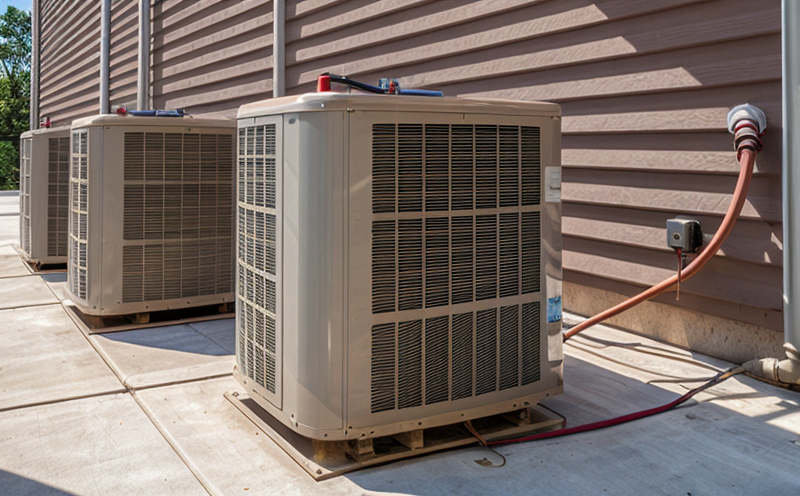ISO 23789 Testing of Fan Coil Units
The International Organization for Standardization (ISO) has established ISO 23789:2018, which provides a method for the determination of energy efficiency, thermal performance, and acoustic characteristics of fan coil units in HVAC systems. This standard is essential for ensuring that fan coil units meet specified performance criteria, enhancing system energy efficiency, and promoting sustainable building design.
Fan coil units are integral components within HVAC systems used to provide heating or cooling directly to rooms or zones. The testing outlined in ISO 23789 helps verify the accuracy of manufacturers' claims regarding these parameters while ensuring that installations comply with local regulations and standards. This service is particularly important for quality managers, compliance officers, R&D engineers, and procurement teams who need to ensure product performance and regulatory adherence.
The standard covers various aspects including:
- Thermal performance metrics such as heating capacity, cooling capacity, and energy efficiency ratio (EER).
- Airflow characteristics including static pressure drop and air volume flow rate.
- Acoustic performance parameters like sound power level and noise reduction coefficient.
The testing process involves several steps. Initial calibration of the test equipment is critical to ensure accurate measurements. Specimen preparation includes verifying the unit's configuration, connection points, and any modifications that may affect the test results. During the testing phase, real-world operating conditions are simulated under controlled laboratory settings to mimic actual usage scenarios. Instruments like thermocouples, anemometers, sound level meters, and pressure gauges are used to collect data.
Reporting of the test results follows a structured format prescribed by ISO 23789, detailing all parameters tested along with their respective values and compliance status against specified thresholds. This information is invaluable for stakeholders involved in selecting, specifying, and installing fan coil units in HVAC systems.
Applied Standards
The testing of fan coil units according to ISO 23789 is aligned with other international standards aimed at promoting sustainable building design and efficient HVAC systems. These include:
- ISO 5151:2014 - Ventilation, Air-conditioning and Refrigeration Systems - Design and Operation for Energy Efficiency.
- EN 13777-1:2018 - Fan coil units with or without integrated terminal unit - Part 1: Classification, performance requirements, design, construction, testing and marking.
- ASTM E965-15 - Test Method for Sound Power of Air Conditioners, Heat Pumps, and Fans.
The application of these standards ensures that the fan coil units tested meet not only local regulations but also global best practices in HVAC design. Compliance with such standards is crucial for manufacturers to ensure their products are reliable and perform as expected under real-world conditions.
Why Choose This Test
Selecting ISO 23789 testing for fan coil units offers numerous benefits, making it a preferred choice among professionals in the building & infrastructure sector. Here are some compelling reasons:
- Enhanced Quality Assurance: Rigorous testing ensures that all components of the fan coil unit perform optimally under various conditions.
- Regulatory Compliance: By adhering to ISO 23789, manufacturers and installers ensure their products meet international standards and local regulations.
- Improved Energy Efficiency: Testing helps identify areas for improvement in energy consumption and operational efficiency.
- Promotes Sustainability: The standard supports the development of more environmentally friendly HVAC systems.
- Informed Decision-Making: Detailed test reports provide comprehensive insights, aiding informed procurement decisions.
The testing process is conducted by highly skilled technicians using state-of-the-art equipment. This ensures accurate and reliable results that are crucial for maintaining the integrity of HVAC systems in buildings.
Use Cases and Application Examples
The application of ISO 23789 is wide-ranging, with numerous use cases across various sectors:
- New Construction Projects: Ensures that fan coil units are correctly specified and installed to meet energy efficiency targets.
- Existing Building Retrofits: Verifies the performance of existing units before and after renovations or replacements.
- R&D & Innovation: Allows manufacturers to innovate by testing new designs against established benchmarks.
- Sustainability Reporting: Provides data for sustainability reports, helping organizations meet their green building goals.
In practice, the test results are used by quality managers to verify product performance and compliance. Compliance officers rely on these tests to ensure regulatory adherence. R&D engineers use them to refine new products or improve existing ones. Procurement teams benefit from detailed reports that inform purchasing decisions.





